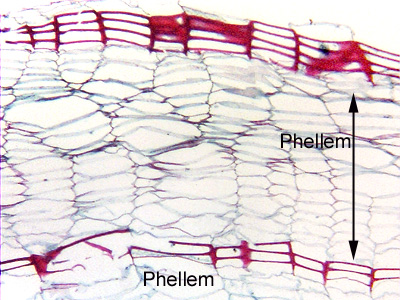 Fig.
17.1-3. Transverse section of root bark (Oreocereus celsianus,
a cactus). This is a fairly common type of bark, containing alternating bands of
phellem (cork) and sclereids. In this species, each cork cambium cell produces
many cells of cork (about 15 to 20) between each band of sclereids (only about
two to four per layer). It is not known what stimulates some cells to
differentiate as sclereids, others as cork cells.
Fig.
17.1-3. Transverse section of root bark (Oreocereus celsianus,
a cactus). This is a fairly common type of bark, containing alternating bands of
phellem (cork) and sclereids. In this species, each cork cambium cell produces
many cells of cork (about 15 to 20) between each band of sclereids (only about
two to four per layer). It is not known what stimulates some cells to
differentiate as sclereids, others as cork cells.
This type of bark breaks off of roots very easily, and it is almost impossible to dissect a root, fix and process it and still have very much bark left on the root – most has fallen off during handling because the phellem layers are so fragile.
These sclereids have rather thin secondary walls, but in some species, they can have walls so thick there is almost no lumen left.
These cells are shown in tangential section in following micrographs.